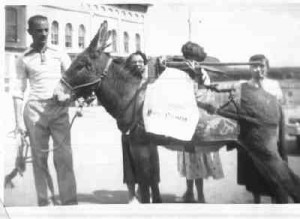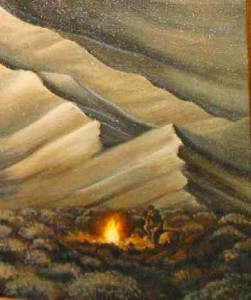Essay by Bill Croke
Wildlife – July 2004 – Colorado Central Magazine
AT A RECENT BARBECUE on the South Fork of the Shoshone River, I saw a huge beaver floating in the river’s current like a big dog. The beaver looked to be about three feet long from nose to flat tail, and must have weighed 40 pounds. It had a huge, whiskered head that reminded me of a Scottish terrier.
Our host, one of those modem cowboys who makes a living thanks to a computer and high-speed Internet service, called us over to look. We stood around with our beers, watching with amazement. My friend’s place sports some huge cottonwood trees, right down by the river. He took lots of pictures but also studied that beaver with some alarm.
As the animal slowly swam upriver, it seemed to scan the jumble of trembling young willows and cottonwood that covered the opposite bank. Our host suddenly mentioned that he’d had a crab apple tree ransacked by a grizzly last year.
A beaver isn’t a grizzly, of course, but you get the idea: It can do a lot of rearranging of the scenery. All of this got me thinking about the role this durable aquatic rat — Castor canadensis — played in the history of the American West. In fact, we might not be here without them. The beavers started it all, by inspiring our relentless move into the country’s interior.
Beaver was once the fabric of choice for hats. In the 17th century; the French methodically worked their way west from eastern Canada and explored half a continent in their pursuit of pelts. By the 1790s, British traders were probing the Pacific coast in search of furs.
Though Thomas Jefferson sent Lewis and Clark on their legendary journey of discovery in 1804 for a myriad of reasons, a major object was to open the region to American trappers. One of them, John Colter, discovered what is now Yellowstone National Park in 1807. Three years later, John Jacob Astor sent the ship Tonquin and its crew to establish Astoria, the first city in Oregon, a place originally devoted to the fur trade.
From the mountain men and fur trappers, to the settlers who followed in wagon trains, the West’s population boom was under way.
Today, the beaver is seen as a nuisance across much of the subdivided West. This totemic animal and its engineering machinations are responsible for flooded subdivisions and chewed-down ornamental trees.
It’s a typical story in the New West: People love wildlife until it eats the pets, shreds the shrubbery, or floods the basement. As for the beaver, it’s spawned a new breed of trapper: Politically correct newcomers want problem wildlife trapped alive and unharmed, then relocated to more natural — and convenient — surroundings.
Just type “Live Trapping Services” into Google or some other search engine, and listings pour in from across America. What would Jim Bridger and Kit Carson make of these modern-day mountain men who make a living returning beavers to the wild?
OCCASIONAL NUISANCE or not, Castor canadensis should be credited for possessing a quality that author Wallace Stegner said was lacking in many of us. Stegner believed that for the West to become a society that matched its scenery, it needed “stickers,” residents willing to commit to a place, weathering its busts as well as its booms, and working to create durable Western institutions.
That’s what beaver did; they stuck and weathered the seasons and built dams that tamed floods. And for thanks we’ve subjected them to trapping and destroyed their lodges with dynamite.
Yet, given a chance, the beaver and its progeny get right back to work.
The same might be said for my friend and his entrepreneurial adventures in cyberspace. He seems rooted, so I assume he’ll stay in the West. But you never know what people — or the economy — will do.
A bunch of us stood watching that big beaver swimming upstream, and I wondered if it would return some night to have a go at my friend’s luscious cottonwoods. My friend was already talking about putting heavy chicken wire around his trees.
I imagined the drama that might play out between these two determined Westerners. And the young willows across the river trembled in the breeze.
Bill Croke is a contributor to Writers on the Range, a service of High Country News. He writes in Cody, Wyoming.>


